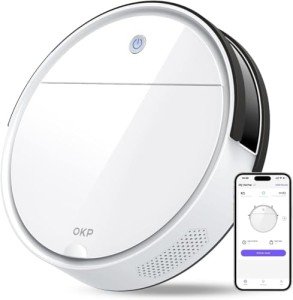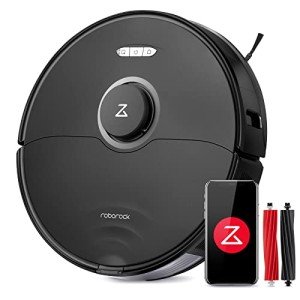
24
AprilWhat's The Job Market For Which Robot Vacuum Cleaner Professionals?
Finding Your Perfect Cleaning Companion: A Guide to Choosing the Right Robot Vacuum Cleaner
The hum of a robot vacuum diligently working its way throughout your floors has actually become a progressively familiar sound in modern homes. These automated cleaning marvels have actually moved from futuristic novelty to household necessary, using an alluring promise: reclaiming your valuable time from the drudgery of vacuuming. With hectic schedules and a desire for cleaner home, it's not surprising that robot vacuums are skyrocketing in popularity.

But stepping into the world of robot vacuums can feel like browsing a complex labyrinth. The market is flooded with alternatives, each promising superior cleaning power, advanced navigation, and intelligent functions. From affordable standard models to high-end robotics loaded with innovative innovation, the large range can be overwhelming. So, how do you sift through the sound and figure out which robot vacuum is truly the right suitable for your home and way of life?
This guide aims to debunk the procedure, offering you with a thorough overview of the crucial factors to consider when picking a robot vacuum cleaner. By comprehending these functions and carefully examining your needs, you can with confidence pick a robotic assistant that will effortlessly integrate into your life and keep your floorings clean without you lifting a finger.
Secret Features to Consider When Choosing a Robot Vacuum Cleaner
Navigating the requirements and marketing lingo surrounding robot vacuums can be intimidating. To streamline your decision-making, focus on these essential features that directly effect performance, benefit, and total complete satisfaction:
Suction Power: This is probably the most basic aspect of any vacuum cleaner, robotic or traditional. Suction power figures out how successfully the robot can lift dirt, dust, particles, and pet hair from your floors. Measured in Pascals (Pa), greater suction power usually equates to better cleaning efficiency, particularly on carpets and rugs.
- Consider your floor types: Hardwood floorings and tile require less suction power than medium-pile or high-pile carpets. If your home is mostly carpeted, focus on robotics with greater suction abilities.
- Try to find adjustable suction levels: Some robotics offer adjustable suction settings, allowing you to customize the power based on the surface area being cleaned up. This can be helpful for delicate rugs or optimizing battery life on tough floors.
Navigation and Mapping: How a robot vacuum navigates your home is crucial for efficient and thorough cleaning. Different navigation innovations exist, each with its own strengths and weak points:
- Random Bounce Navigation: Simpler and frequently discovered in spending plan models, these robotics move arbitrarily, bouncing off challenges up until they cover the area. While they ultimately clean, they might miss out on areas and are less efficient.
- Systematic Navigation (Row-by-Row): These robotics clean in arranged rows, making sure more complete coverage and efficient cleaning patterns.
- Smart Mapping (LiDAR or vSLAM): Advanced robots use LiDAR (Light Detection and Ranging) or vSLAM (visual Simultaneous Localization and Mapping) to produce detailed maps of your home. This enables:
- Efficient path planning: Optimizing cleaning routes for faster and more thorough cleaning.
- Room-specific cleaning: Directing the robot to clean specific rooms or zones through an app.
- Virtual limits and no-go zones: Setting up virtual walls or no-go zones to prevent the robot from getting in particular areas or harmful delicate items.
- Multi-floor mapping: Storing maps for multiple floorings in your home, perfect for multi-level homes.
Battery Life and Coverage Area: The battery life of a robot vacuum determines for how long it can clean on a single charge and consequently, the area it can cover.
- Consider your home size: Larger homes require robotics with longer battery life. Take notice of the producer's mentioned runtime and coverage location, remembering these are typically estimates under perfect conditions.
- Auto-recharge and resume: Many robots include auto-recharge and resume performance, permitting them to immediately go back to their charging dock when the battery is low, recharge, and then resume cleaning where they ended. This function is particularly essential for larger homes.
Dustbin Capacity: The size of the dustbin effects how often you need to empty it.
- Consider your cleaning frequency and pet situation: If you have pets or run your robot vacuum uk vacuum regularly, a larger dustbin is more effective to lessen emptying frequency. Smaller dustbins may be adequate for smaller homes or less regular cleaning schedules.
- Self-emptying dustbins: Some premium models include self-emptying bases. After each cleaning cycle (or several cycles), the robot immediately transfers gathered debris into a bigger bin in the base, considerably decreasing manual emptying.
Smart Features and App Control: Modern robot vacuums frequently come geared up with smart features controllable through a smartphone app. These functions can considerably boost benefit and customization:
- Scheduling: Set cleaning schedules to automatically run the robot at particular times, even when you're not home.
- Remote control and tracking: Start, stop, and screen cleaning progress from another location through the app.
- Zone cleaning and spot cleaning: Direct the robot to clean specific areas or spills on need.
- No-go zones and virtual walls: Define areas the robot should prevent, protecting fragile products or preventing access to specific rooms.
- Voice control combination: Control the robot with voice commands via smart home assistants like Amazon Alexa or Google Assistant.
- Cleaning history and reports: Track cleaning history, view maps, and get efficiency reports.
Mopping Functionality (2-in-1 Models): Some robot vacuums use a 2-in-1 performance, integrating vacuuming and mopping in a single device.
- Consider your floor types and cleaning needs: 2-in-1 robots can be practical for homes with tough floorings, offering a dual cleaning action. Nevertheless, mopping functionality typically differs in effectiveness and may not change a dedicated mop for heavy-duty cleaning.
- Types of mopping: Look for info on the mopping system used. Some utilize simple wet fabrics, while others provide vibrating or oscillating mop pads for more reliable scrubbing. Water tank size and adjustable water circulation settings are likewise appropriate factors to consider.
Brush Roll and Filtration: The design of the brush roll and filtration system impacts cleaning efficiency and is particularly crucial for allergic reaction sufferers.
- Brush roll types: Different brush roll styles are better matched for different floor types. Look for:
- Bristle brushes: Effective for carpets for agitating and lifting embedded dirt.
- Silicone/Rubber fin brushes: Gentler on tough floorings and much better at handling pet hair, minimizing tangling.
- Combination brushes: Designed to work well on both carpets and difficult floors.
- Filtering systems: HEPA filters are crucial for recording fine dust, allergens, and pet dander, improving air quality. Consider the type of filtering system and whether replacement filters are readily offered and economical.
- Brush roll types: Different brush roll styles are better matched for different floor types. Look for:
Noise Level: Robot vacuums produce sound during operation, though typically less than traditional vacuums.
- Consider noise level of sensitivity and cleaning times: If you are delicate to sound or strategy to run the robot while you are home, inspect the noise level requirements (measured in decibels - dB). Lower dB values indicate quieter operation.
Cost and Budget: Robot vacuums span a broad cost range, from budget-friendly choices to premium designs.
- Identify your budget plan: Set a reasonable budget before you start going shopping. Prioritize the features essential to you within your budget plan.
- Balance features and cost: Consider which robot vacuum cleaner (try these out) features are important for your requirements and which you can live without. Often, mid-range designs use a great balance of functions and efficiency without breaking the bank.
Navigating the Choice: Matching Features to Your Needs
Picking the ideal robot vacuum isn't about finding the "best" design in general, but rather the best design for you. By carefully considering your specific needs and concerns, you can make a notified decision:
- For Pet Owners: Prioritize robots with strong suction, tangle-free brush rolls (silicone or rubber fin brushes are typically advised for pet hair), HEPA filters, and larger dustbins.
- For Homes with Carpets: Focus on robots with high suction power, bristle brushes, and potentially adjustable brush head height for ideal carpet cleaning.
- For Homes with Hard Floors: Navigation, systematic cleaning patterns, and even 2-in-1 mop/vacuum functionality become more vital. Suction power requirements may be somewhat lower.
- For Large Homes: Battery life, auto-recharge and resume, and efficient navigation with mapping are crucial for covering bigger locations successfully.
- For Tech Enthusiasts: Explore robotics with sophisticated smart features, app control, voice combination, and in-depth mapping abilities.
- For Budget-Conscious Buyers: While basic models might lack innovative features, they can still supply automated cleaning. Concentrate on necessary features within your spending plan, such as decent suction and standard navigation.
Making Your Final Decision
Choosing a robot automatic vacuum cleaners cleaner is a financial investment in benefit and a cleaner home. By comprehending the key functions and aligning them with your specific requirements, you can with confidence navigate the market and find the ideal robotic vacuum cleaners uk cleaning buddy. Remember to check out evaluations, compare requirements, and ultimately choose a design that will seamlessly integrate into your life and help you recover your time and enjoy a cleaner, more comfortable living area.

Regularly Asked Questions (FAQs) about Robot Vacuum Cleaners
- Are buy robot cleaner vacuum cleaners worth it?
- For numerous, yes. Robot vacuums use significant convenience by automating floor cleaning, conserving effort and time. They are particularly beneficial for busy people, pet owners, and those with mobility limitations.
- For how long do robot vacuum last?
- The lifespan varies depending on the brand, model, and use. Generally, an excellent quality robot vacuum can last for 3-5 years with correct upkeep. Battery life tends to degrade in time and may need replacement eventually.
- Can robot vacuums change routine vacuums?
- For day-to-day or routine upkeep cleaning, robot vacuums can considerably minimize the requirement for conventional vacuuming. However, for deep cleaning, reaching corners, stairs, or upholstery, a conventional vacuum might still be essential. Lots of individuals use robot vacuums for routine cleaning and supplement with a stick or portable vacuum for spot cleaning and more intensive tasks.
- Do robot vacuums work on carpets?
- Yes, numerous robot vacuums work well on carpets, especially models with strong suction and bristle brushes. Nevertheless, performance can differ depending on carpet pile height and robot design. Inspect requirements and reviews to make sure the robot appropriates for your carpet type.
- Do robot vacuums deal with animals?
- Many robot vacuums are developed to manage pet hair successfully. Look for designs with tangle-free brush rolls, strong suction, and HEPA filters to record pet dander and allergens. Clearing the dustbin more often might be necessary with family pets.
- How often should I run my robot vacuum?
- The perfect cleaning frequency depends on your requirements and way of life. Daily cleaning is beneficial for high-traffic locations and pet owners. Running the robot a few times a week may be sufficient for less busy households. Scheduling functions make it easy to automate cleaning according to your preferred frequency.
- How do I keep a robot vacuum robot cleaner?
- Regular maintenance is vital for optimal performance and longevity. This includes:
- Emptying the dustbin routinely.
- Cleaning the brush roll and side brushes of hair and particles.
- Cleaning or replacing filters as recommended by the producer.
- Cleaning down sensors and charging contacts.
- Looking for and clearing any blockages in the robot's course.
- Regular maintenance is vital for optimal performance and longevity. This includes:
By considering these elements and addressing these FAQs, you are well-equipped to browse the world of robot vacuum cleaners and find the perfect automated cleaning option for your home. Pleased cleaning!
Reviews